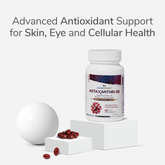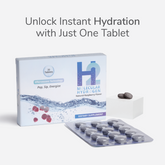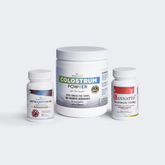Estimated Reading Time: 7 minutes
|Did you know that colostrum can be collected in advance for use?
Colostrum, the first milk produced by mammals, is crucial for newborns of all mammals. It provides essential nutrients, immune support, gut health benefits, and growth factors. It plays a vital role in transferring antibodies from the mother and helps newborns build passive immunity and protect against infections in the early days of life.
But why collect colostrum in the first place?
Collecting colostrum can be a proactive way to support human babies who may struggle to latch, need extra nourishment, or are facing medical challenges. Hold on! Did you know colostrum is commonly sourced from cows, too? In that case, it's termed Bovine colostrum. For farmers, collecting bovine colostrum from cows ensures that calves receive every essential nutrient, including protective antibodies, right from birth.
Bovine colostrum is gaining popularity as a supplement for humans and pets, for its gut health, immunity, and overall health benefits. Proper collection and storage preserve its effectiveness, whether for infants, animals, or human supplementation.
Let's learn more about why and how to collect colostrum and store it to ensure the best possible start to life.
Key Facts
|
Also Read: Benefits of Bovine Colostrum Supplements for Adults
What Is Colostrum Harvesting—and When Can You Start?
In simple words, ‘colostrum harvesting’ is collecting and storing your colostrum.
Mammary glands begin making colostrum while you’re pregnant, at around 16-17 weeks. The timings may vary from person to person.
You can begin expressing colostrum from week 36 of pregnancy. Always check with your healthcare provider or lactation expert first.
Still wondering, WHY?
Just keep scrolling to curb that curiosity!
Why Collect Human Colostrum?
There can be various reasons that you should collect colostrum in advance, such as:
-
Preparing for Feeding Challenges
There can be cases when feeding naturally becomes troublesome, such as:
-
If your baby has trouble latching
-
Premature birth, or
-
Multiple birth (twin or triplet)
Being smart and storing colostrum helps you make sure your little one still receive vital early nutrients.
-
Supporting Special Health Needs
Some babies are born with medical conditions like
-
Low blood sugar
-
Down’s syndrome
-
Congenital abnormalities
-
Heart complications, or
-
Cleft lip/palate
These newborns may need extra colostrum to stabilize their health and support their early development. And colostrum harvesting can be a savior!
-
Maternal Health Conditions
Mother’s health plays a vital role in colostrum production. So, if you have:
-
A history of low milk production
-
Breast hypoplasia
-
Polycystic ovarian syndrome (PCOS), or
-
Previous breast surgery, consider collecting colostrum in advance.
It can be helpful to provide a crucial nutritional start for your baby.
There are few other medical conditions that might impact milk production and require new mothers to collect colostrum. These are:
-
Diabetes (including gestational diabetes)
-
Pre-eclampsia
-
High blood pressure (requiring beta blockers like labetalol), or
-
Raised BMI
-
Planning for a Caesarean Birth
Expecting to deliver via C-section? Having stored colostrum can help ensure your baby gets early nourishment while waiting for your milk to come in.
So, now when the “WHY” is clear, let’s explore “HOW”!
How to Collect Human Colostrum?
Your breasts make only a small quantity of colostrum. Thus, it is better that you:
-
Collect the colostrum using your hands.
-
Avoid using a breast pump, which you can use later after giving birth.
-
You can start collecting for a few minutes every day initially.
-
Gradually build up the frequency to 5 to 10 minutes at one time for 2 to 5 times per day.
You can follow these steps to collect colostrum:
1️. Prepare
Wash hands thoroughly with soap and dry them well. Also, ensure you have a clean and sterilized container/ spoon/ syringe.
2️. Massage
Gently massage your breasts with your hands in a circular motion to stimulate flow.
Begin from the outside of your breast and move your hands towards your nipple.
3️. Position Your Hand
Cup your hand around one breast and form a C shape around the nipple with four fingers under the breast and the thumb at the top. Place your fingers around the areola and gently compress toward the nipple.
4. Hand Express
Gently squeeze your thumb and index finger. Avoid pinching or holding too tight. Release and repeat in rhythmic motion.
5. Collect
Collect the expressed colostrum in a sterile syringe, spoon, or small container. Repeat the process with the second breast.
How to Store Human Colostrum?
You can store colostrum in
-
A syringe or
-
Container in the refrigerator.
Note: Before storing, cover the syringe with a cap and put it in a plastic bag. Ensure that you’ve labeled it with the date and/or time of collection.
Refrigeration: Store at 4°C or below (39°F) for up to 48 hours.
Freezing: Freeze at -18°C (0°F) or below for up to 6 months.
Consumption Tip:
Thawing: Warm in a bowl of warm water before feeding (never microwave).
At the very beginning of the blog, you learnt of a boon, i.e, Bovine Colostrum. So, let’s understand a little more about its journey. Shall we?
From Cow to Capsule: The Journey of Bovine Colostrum
Bovine colostrum which is known for its immune-supporting and gut-healing properties has become a popular supplement worldwide.
But ever wondered how it’s actually collected and processed?
It all starts soon after a cow gives birth.
The first milk, or colostrum, is harvested within the first few hours (ideally within 6 hours) of calving. This timing is crucial, as it ensures maximum concentration of antibodies, growth factors, and bioactive compounds.
Once collected, the colostrum undergoes careful pasteurization to eliminate pathogens while preserving its nutrients.
After that, it's gently dried (spray or freeze drying) and standardized to ensure consistent quality and potency.
The final product is then used in capsules, powders, or functional foods, designed to support human immunity, gut health, and recovery.
So, whether it’s to support a newborn calf or packaged as a health-boosting supplement for you, bovine colostrum goes through a meaningful path; from the farm to your shelf.
Colostrum Supplements: Why Early Collection MattersColostral IgG (Immunoglobulin G) Levels Drop by 3.7% Every Hour After CalvingEarly Collection = Higher IgG & More Immune Benefits ️ |
All In All: The Power of Colostrum – From Birth to Supplementation
Colostrum harvesting ensures the young one receives health benefits such as immune support, gut protection, and essential nutrients when direct breastfeeding isn’t an option. The same holds true for calves, as timely colostrum feeding ensures their survival, growth, and long-term health benefits.
In addition, bovine colostrum is emerging as a potent supplement that supports digestive health, the immune system, muscle recovery, and complete well-being. Best practices for collecting and processing colostrum ensure maximizing its benefits while also assuring the best quality. The process also helps to widen the reach of this nutrient-rich superfood to those who need it most.
Frequently Asked Questions
Q1. What is the easiest way to collect colostrum?
Hand expression is the easiest way for colostrum collection. Gently massage your breast and express small drops into a clean container or syringe.
Q2. When should I start collecting colostrum?
You can start around 36 weeks if advised by your doctor. However, it’s not necessary for everyone.
Q3. How to collect colostrum during pregnancy?
Wash your hands, gently massage your breasts, and use your fingers to express colostrum into a clean container or syringe.
Q4. Can I use a breast pump to collect colostrum?
Yes, you can, but hand expression is usually more effective for small amounts. A pump may not work well as the colostrum quantity is very small, and it is thicker.
Q5. Is frozen colostrum good for sick baby?
Yes, frozen colostrum is beneficial and packed with antibodies, and immune-boosting properties.
Q6. Can you give colostrum to older babies?
Yes, you can give colostrum to support their overall health. It is especially beneficial for sick babies and those with weak immunity.
Q7. How do you know when colostrum is ready?
It’s ready when you notice thick, yellowish or clear fluid coming from your breasts, usually after 16-20 weeks.
References:
-
Playford, Raymond John, and Michael James Weiser. "Bovine colostrum: Its constituents and uses." Nutrients 13.1 (2021): 265. https://pmc.ncbi.nlm.nih.gov/articles/PMC7831509/
-
Dande, Nivedita Deepak, and Prajakta Jayant Nande. "Nutritional composition of bovine colostrum: palatability evaluation of food products prepared using bovine colostrum." International Journal of Nutrition, Pharmacology, Neurological Diseases 10.1 (2020): 8-13. https://journals.lww.com/ijnp/fulltext/2020/10010/nutritional_composition_of_bovine_colostrum_.2.aspx
-
Arslan, Ayşenur, et al. "Bovine colostrum and its potential for human health and nutrition." Frontiers in Nutrition 8 (2021): 651721. https://pmc.ncbi.nlm.nih.gov/articles/PMC8255475/









![Top 5 Best Vitamins for Men in Their 30s [Backed by Science!]](http://wellnessextract.com/cdn/shop/articles/Vitamin_for_men_8fe0fe21-19b1-4020-b895-dc104449637e_165x.webp?v=1765878148)




























